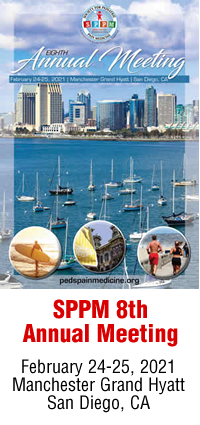Meeting Reviews
The Child with Osteosarcoma
By Aaron C. Spicer, MD, MAS, FAAP
Department of Anesthesiology, Critical Care and Pain Medicine
Boston Children’s Hospital
Harvard Medical School
Boston, Massachusetts
This session represented a truly multidisciplinary take on osteosarcoma, with input from an orthopedic tumor surgeon (Dr. Peter Rose), perioperative anesthesiologist (Dr. Karen Dean), physiatrist (Dr. Bradford Landry), and palliative care and pain pediatrician (Dr. Stefan Friedrichsdorf).
The session began with Dr. Rose presenting some of the information used by surgeons in deciding whether limb sparing surgery or amputation may be preferred. Ultimately, patient survival does depend on both adequate surgical and chemotherapeutic control of the tumor. Limb sparing surgery requires that excision with a sufficient margin be possible without destroying limb function. Limb sparing therapy is performed in many cases but can result in leg length discrepancy or endoprosthetic failure. Limb function may be more robust after amputation or rotationplasty, in which the ankle joint is converted for use as a knee joint. Long term outcomes are similar for all surgical techniques.
Next, Dr. Dean reviewed mechanisms of pain after limb sparing surgery and amputation, noting that amputation may be further complicated by stump pain, phantom limb sensation, and phantom limb pain. She reviewed mechanisms of those processes and presented data that phantom limb sensation and pain may be quite prevalent. Next, she briefly reviewed the mechanisms by which various analgesics and neuropathic agents work, and some evidence of their utility. Finally, she suggested a practical approach of regional or neuraxial analgesia, NSAID, acetaminophen, opioid, gabapentin, non-pharmacologic perioperative therapy, and consideration of ketamine.
Dr. Landry reviewed the goals of cancer rehabilitation and when to begin therapy. He described goals of physical and occupational therapy in general. He divided the potential phases of rehabilitation care into pre-rehabilitation, post-op rehabilitation, and long-term management. Pre-rehabilitation consists of education and training, baseline functional assessment, and setting goals for postoperative recovery. Post-operative rehabilitation can be further divided into the acute phase (the first two postoperative weeks), which largely consists of preparation for safe, functional discharge, and the subacute or intermediate phase (two-six weeks postoperatively), with the goal to return to independent or modified independent function and mobility. The late or long-term phase aims to improve overall endurance and function, increase strength of the affected limb, and discontinue assistive devices as tolerated. He emphasized the role of rehabilitation services in non-pharmacologic pain management, and reinforced Dr. Rose’s point that functional outcomes are similar with limb sparing surgery vs. amputation.
Dr. Friedrichsdorf emphasized the prevalence of distressing symptoms among children with advanced illness, particularly cancer, including among those with congenital abnormalities and/or developmental delay. He presented strong evidence that these symptoms are ameliorated by involvement of palliative care services; in addition to improved pain, dyspnea and anxiety, they report having more fun and meaning in their lives, as well as shorter hospitalizations and fewer emergency department visits. He reviewed the contributing factors to pain and distress at the end of life, with discussion of potential mechanisms and treatment options.
He presented 12 tiers of treatment in a stepwise, escalating approach to treat pain in children with serious illness:
- evaluation;
- treating the underlying causes;
- integrative therapies;
- social work, rehabilitation, psychology, spirituality, child life;
- basic analgesia and opioids, with consideration for opioid rotation;
- gabapentinoids and/or tricyclic antidepressants;
- alpha-2-adrenergic agonists;
- NMDA-receptor antagonists;
- sodium-channel blockers such as lidocaine;
- regional techniques;
- other adjuvants; and finally, in rare circumstances,
- palliative sedation.




